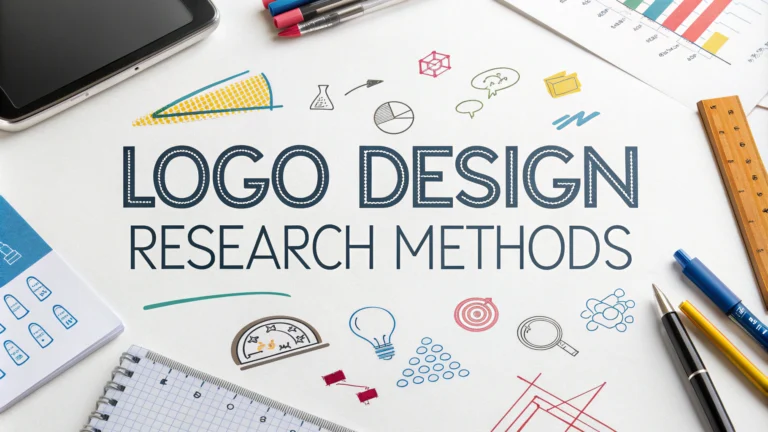Research forms the foundation of successful logo design, helping designers create meaningful and effective visual identities.
Before starting any logo design project, gather essential information about the client’s business, target audience, competitors, and industry through these proven methods:
1. Client Questionnaire
- Company history and values
- Target audience demographics
- Brand personality traits
- Color preferences and restrictions
- Design style preferences
- Competitors to watch
2. Market Analysis
- Study direct competitors’ logos
- Analyze industry design trends
- Review successful rebrands in similar sectors
3. Visual Research
Create mood boards using tools like Pinterest or Behance to collect inspiring logos, color schemes, and design elements.
4. Target Audience Research
- Conduct surveys or interviews
- Study demographic data
- Review social media engagement
- Analyze purchasing behaviors
5. Technical Requirements
- Logo usage scenarios (digital, print, merchandise)
- Size requirements
- Color format needs (CMYK, RGB, Pantone)
- File format specifications
Research Tools
| Tool | Purpose |
|---|---|
| Google Forms | Client questionnaires |
| Visual research | |
| Behance | Design inspiration |
| SurveyMonkey | Audience research |
Documentation Tips
- Keep organized files of research findings
- Create shareable presentations for clients
- Document all client feedback
- Save inspiration sources for reference
Use these research findings to create a design brief that guides your logo development process.
Contact professional logo design associations like AIGA (www.aiga.org) for additional resources and guidelines.
Common Research Mistakes to Avoid
- Skipping competitor analysis
- Rushing through client questionnaires
- Ignoring technical requirements
- Not documenting research findings
Implementation Process
1. Research Analysis
- Review collected data systematically
- Identify key patterns and insights
- Create summary reports
- Share findings with stakeholders
2. Design Strategy Development
- Define core brand attributes
- Establish design parameters
- Set measurable objectives
- Create timeline milestones
3. Concept Development
- Sketch initial ideas based on research
- Create digital variations
- Test concepts against research criteria
- Prepare client presentations
Quality Assurance
Research Validation
- Cross-reference findings with industry standards
- Verify data accuracy
- Update research as needed
- Document validation process
Conclusion
Thorough research ensures logo designs meet client objectives, resonate with target audiences, and stand out in the marketplace. Following these systematic research methods helps designers create meaningful, lasting visual identities that drive brand success.
Remember to:
- Maintain detailed research records
- Update findings regularly
- Apply insights throughout the design process
- Measure results against research objectives
FAQs
- What are the most effective research methods for logo design?
Competitor analysis, target audience surveys, mood boarding, market research, client interviews, industry trend analysis, focus group discussions, social media listening, historical brand research, and visual preference testing. - How important is target audience research in logo design?
Target audience research is crucial as it helps determine color preferences, cultural sensitivities, demographic expectations, and visual elements that resonate with the intended market, ensuring the logo effectively communicates with its primary viewers. - What tools can I use for logo design research?
Google Analytics, Survey Monkey, Pinterest for mood boards, Brand24 for social listening, Behance for design inspiration, Google Trends for market analysis, LinkedIn for industry insights, and professional design forums. - How long should the research phase take in logo design?
The research phase typically takes 2-4 weeks, depending on project scope, client availability, market complexity, and depth of research required. Rushing this phase can lead to ineffective design outcomes. - What should be included in competitor logo analysis?
Color schemes, typography choices, symbol usage, overall style, market positioning, brand personality, logo versatility, historical changes, cultural implications, and industry standards. - How do you conduct effective client interviews for logo research?
Ask about brand values, target audience, company history, future goals, preferred styles, competitors, industry challenges, brand personality, color preferences, and specific design requirements. - What role does psychology play in logo design research?
Psychology research helps understand color meanings, shape perceptions, emotional responses, cultural associations, visual hierarchy, memory retention, brand recognition, and consumer behavior patterns. - How do you research logo scalability and versatility?
Analyze logo usage across different mediums, test various sizes, check digital and print applications, examine mobile responsiveness, assess social media requirements, and evaluate production constraints. - What industry-specific factors should be researched?
Industry regulations, cultural considerations, competitor positioning, sector-specific color conventions, technological limitations, market trends, geographical influences, and customer expectations. - How do you validate logo design research findings?
Through focus group testing, client feedback sessions, A/B testing, stakeholder reviews, target audience surveys, expert consultations, market testing, and comparative analysis with successful industry examples.








